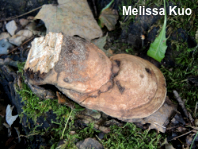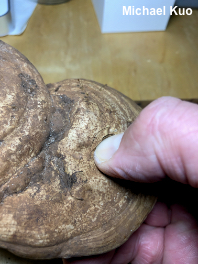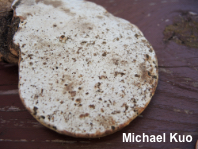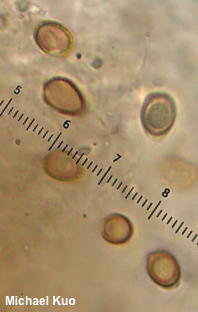| Major Groups > Polypores > Ganoderma > Ganoderma lobatum |

|
Ganoderma lobatum [ Basidiomycota > Polyporales > Polyporaceae > Ganoderma . . . ] by Michael Kuo Like the well-known "artist's fungus," Ganoderma applanatum, Ganoderma lobatum features a white, brown-bruising pore surface that can be "drawn" on, and a brown to grayish brown cap. Both species are perennial. However, while Ganoderma applanatum grows a new tube layer each year, under the same cap (illustration), Ganoderma lobatum develops an entirely new cap below the previous year's cap, creating a stacked appearance. Additionally, the upper crust of the cap surface is very hard and woody in Ganoderma applanatum, while the crust of Ganoderma lobatum is softer—soft enough to be punctured with one's thumb. Look for Ganoderma lobatum on the deadwood of hardwoods east of the Rocky Mountains and in the southwestern states. Description: Ecology: Saprobic; growing alone or gregariously on decaying logs and stumps of various hardwoods; causing a white rot; annual or perennial, lasting for 1–3 years; widely distributed in North America east of the Rocky Mountains; also found in Arizona and in Mexico. The illustrated and described collection is from Michigan. Cap: 4–10 cm across; 8–14 cm deep; more or less semicircular in outline, or elongated; producing a new cap each year below the last year's cap and confluent with it; surface with a dull, unvarnished outer crust that is soft enough to be punctured with one's thumb, sometimes furrowed in "zones," brownish to grayish brown; bald. Pore Surface: Whitish to pale brownish; bruising brown; with 4–6 tiny, circular pores per mm; tubes 0.5–1.5 cm deep. Stem: Absent. Flesh: Dark brown to cinnamon brown; woody. Odor and Taste: Not distinctive. Chemical Reactions: KOH instantly black on cap surface, flesh, and tubes. Microscopic Features: Spores 6–9 x 4.5–6 µm after the collapse of the hyaline vesicular appendix; more or less ellipsoid, with a truncated end; appearing double-walled, with a series of "pillars" between the walls; finely stippled; inamyloid; reddish brown in KOH. Cystidia and setae not found. Hyphal system trimitic. Clamp connections present. REFERENCES: (Schweinitz, 1832) Atkinson, 1908. (Overholts, 1953; Gilbertson & Ryvarden, 1986; López-Peña et al., 2016.) Herb. Kuo 09281907. This site contains no information about the edibility or toxicity of mushrooms. |
© MushroomExpert.Com |
|
Cite this page as: Kuo, M. (2019, November). Ganoderma lobatum. Retrieved from the MushroomExpert.Com Web site: http://www.mushroomexpert.com/ganoderma_lobatum.html |



